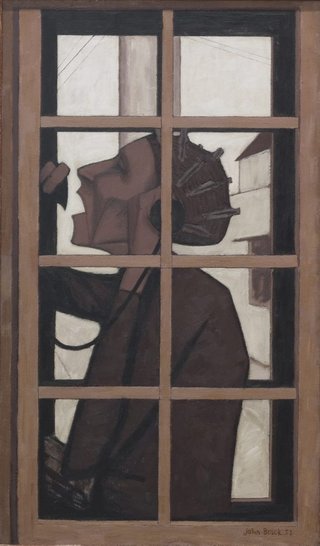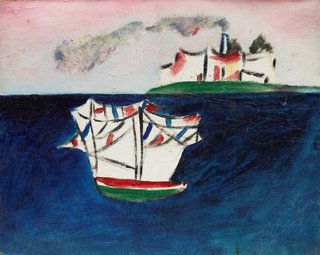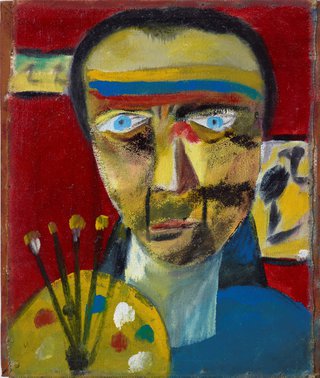Art Sets.
20th-century Australian art: Sidney Nolan and the ‘defence of the image’
Print this setBy the Art Gallery of NSW

AGNSW collection John Brack The breakfast table 1958
The breakfast table by John Brack depicts the traces of a family's morning meal before the cutlery and plates have been cleared away. It captures a simple moment of domesticity, breaking with the pictorial and thematic conventions of the still-life genre. The painting suggests the interactions and traits of the sitters invisible to us. Empty glasses, cups and mugs remain on the table surrounded by plates with scattered crumbs, bottles, knives and jars of fruit conserve.
Brack's palette is arresting: the illuminated, almost fluorescent yellow of the table top contrasts the deep shadows cast by the items on it. He has arranged the objects in an almost geometric pattern, so that objects sit in relation to one another and are intrinsic to the success of the overall composition.

AGNSW collection John Brack The telephone box 1954
This painting depicts a woman in mid conversation in a public telephone box. Her figure is constructed through a series of repeated angular forms, so that she appears to be an extension of the stark geometry of her surroundings. It illustrates John Brack’s strategy of drawing viewers into his work by positioning them as direct and close observers of his subjects. While conversations normally imply connections between people, this work presents the act of communication as strained and isolating.
The telephone box is indicative of the powerful statements about urban experience that the artist exhibited in his initial solo shows in 1953 and 1955, which established him as a significant presence in Australian art.

AGNSW collection John Brack The new house 1953
The new house by John Brack is a depiction of Australian culture during the Menzies era, where the home was viewed as the foundation of the Australian way of life. It portrays a conventional married couple - suburban homeowners - standing in front of their fireplace in a simply adorned interior. A reproduction of van Gogh's Langlois Bridge (1888) hangs above the mantelpiece, while beneath it a small clock marks the time. The white apron worn by the woman, indicative of her domestic duties, suggests that lunch has just concluded.
The new house is strictly composed on a narrow vertical canvas with a precise arrangement of colour. It pervades a sense of flatness, embodied by Brack's smooth application of paint, emphasising the clean, sparse qualities of the room.

AGNSW collection Albert Tucker Apocalyptic horse 1956
Tucker's paintings created outside Australia during the 1950s and 1960s reveal an affinity with the Italian painter Alberto Burri, whom he had met in Rome in 1953–54. Intrigued by the textural quality inherent in polyvinyl acetate (used by Burri to create his evocative built-up surfaces), Tucker adopted the flexible and leathery toughness of this new material into his work.
During his time in Rome in 1954 Tucker also met his friend Sidney Nolan, who had brought with him photographs of the 1952 Queensland drought. Images of desiccated animal carcasses strewn across a parched terrain left an enduring impression on Tucker. Apocalyptic horse was painted in reaction to these images, and is one of several works which display Tucker’s conversion from oils to fast-drying acrylic paint, evoking the shape and texture of the Australian outback.

AGNSW collection Sidney Nolan First-class marksman 1946
First-class marksman shows the isolated figure of Ned Kelly in the solid black armour that is Nolan's most inventive pictorial device, its flat abstracted shape incongruously placed against a landscape of lyrical delicacy. The title refers to an incident which took place in Victoria’s Wombat Ranges, when Kelly and his gang were practising their marksmanship, firing hundreds of rounds at surrounding trees from a bullet-proof hide-out.
Nolan made many paintings of the outlaw Kelly between 1946 and 1947 at Heide, home of patrons John and Sunday Reed. This was the only panel in the series not painted on the Heide dining table, but at the house of Russian expatriate artist Danila Vassilieff at Warrandyte, where Nolan was caretaker for two months.

AGNSW collection Sidney Nolan Robbed 1947
Robbed was created at a key moment in Sidney Nolan's early career. Dating from the artist's important 1946-47 Ned Kelly series, it is one of several paintings that were edited out of the final core of works chosen to represent the Kelly narrative.
Painted when a more lyrical mood had evolved in the series, Robbed is bathed in a soft light, evoking a dreamlike quality - a portent of perhaps of impending violence. The naked figures may be humiliated police, stripped of their uniforms and their horses stolen - possibly the two whom the Kelly gang ambushed at Jerilderie. Alternatively, Robbed may be loosely based on earlier incidents in Kelly's career and intended for the beginning of the series, to portray the germination of the bushranger's notoriety.

AGNSW collection Sidney Nolan Luna Park 1941
Sidney Nolan began his career in Melbourne in 1938 at the age of 21, a largely self-taught, consciously determined innovator. Work by Picasso, Cézanne, Rousseau, Matisse and van Gogh that he saw in the 1939 Herald exhibition of French and British contemporary art at the Melbourne Town Hall profoundly affected his visual imagination.
From the outset, Nolan drew on elements in the everyday world around him that lent themselves to abstraction. In Luna Park, inspired by the linear ironwork grid of the Big Dipper at St Kilda’s celebrated fun fair, Nolan transforms the structure into a pattern of graceful arabesques and rectangles set against the vivid colours of the fair and sky beyond.















